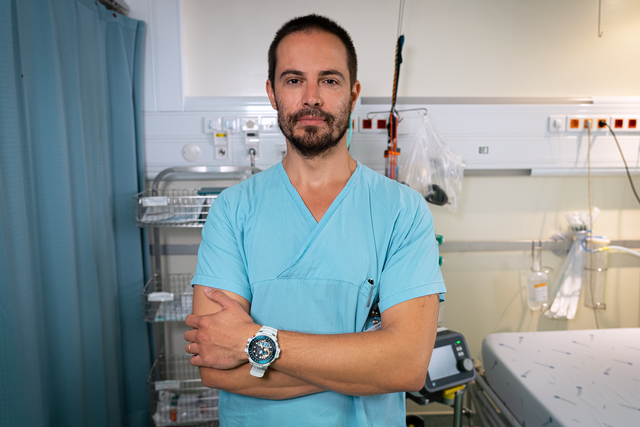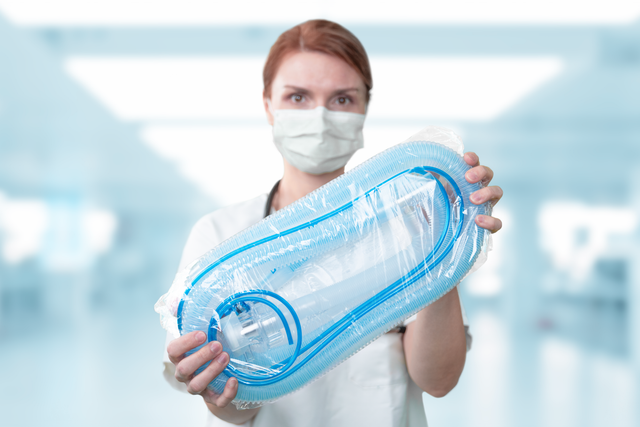
Nuestro respirador de UCI inteligente. El nuevo HAMILTON-C6









El nuevo HAMILTON-C6 le respalda a lo largo de todo el proceso de ventilación de los pacientes, desde su ingreso hasta la retirada, con avanzadas herramientas y funciones que simplifican el flujo de trabajo de principio a fin. Además, hemos desarrollado nuevas soluciones específicamente diseñadas para ayudarle en cada fase del proceso.
En lugar centrarnos en funciones individuales, hemos aplicado un enfoque global que transforma las tareas fragmentadas en un proceso intuitivo simplificado. El resultado es un flujo de trabajo íntegramente diseñado para ofrecer mayor eficiencia operativa, incluso en los entornos de asistencia más exigentes.

Este diseño es el más flexible. Puede colocarlo en un carrito, acoplarlo a un brazo colgante, desmontarlo del cuerpo o colocarlo sobre una repisa.


Con su turbina de alto rendimiento, funcionamiento con batería, tamaño compacto y modos de ventilación de vanguardia, el nuevo HAMILTON-C6 también acompaña a sus pacientes en sus primeros pasos de movilización.

Aprenda en cualquier lugar y en cualquier momento con nuestra aplicación VenTrainer. Ofrece simulaciones de todos los respiradores de Hamilton Medical en 3D, con una interfaz de usuario totalmente funcional, valores de monitorización en tiempo real y un modelo de paciente fisiológico realista con condiciones ajustables (EPOC y SDRA).
La formación adicional y los escenarios de aprendizaje le ofrecen una experiencia de formación guiada y práctica.
Descubra el nuevo respirador HAMILTON-C6 desde todos los ángulos y haga clic en los puntos de información para obtener más detalles.
| Grupos de pacientes | Adultos/pediátricos, neonatos |
|---|---|
| Dimensiones (ancho x largo x alto) | 17 pulgadas (431,8 mm), diagonal 1920 x 1200 píxeles |
| Peso | Monitor (panel de interacción), sin montaje en repisa: 7,8 kg Monitor con montaje en repisa: 10 kg Unidad de ventilación con montaje en repisa: 10,5 kg Unidad de ventilación, monitor y carro: 46 kg |
| Resolución y tamaño del monitor | 423 x 250 x 415 mm (monitor) 360 x 250 x 394 mm (unidad de ventilación) 640 x 560 x 1400 mm (carro incluido) |
| Monitor desmontable | |
| Tiempo de funcionamiento de la batería | 1,5 h con una batería 3 h con dos baterías |
| Batería intercambiable en funcionamiento | |
| Suministro de aire | Turbina integrada cubierta con garantía durante la vida útil prevista del nuevo respirador HAMILTON‑C6 |
| Conector O2 | DISS (CGA 1240) o NIST |
| Conectividad | Tres puertos COM, dos puertos USB, DVI, llamada de enfermera |
| Volumen | 37 dB en funcionamiento normal |
| Control por flujo y por volumen | |
|---|---|
| Volumen objetivo, control por presión adaptable | |
| Pressure-controlled | |
| Ventilación inteligente | ASV®, INTELLiVENT®‑ASV® (opcional) |
| Ventilación no invasiva | |
| Flujo alto | |
| Visualización de la mecánica pulmonar (Pulm. dinámico) | |
|---|---|
| Visualización de la dependencia del respirador del paciente | |
| Capnograma | |
| Monitorización de SpO2 | |
| Lung stress and strain monitoring (Lung Impact panel) | |
| Medición de la presión esofágica |
| Evaluación de reclutamiento y reclutamiento pulmonar (P/V Tool Pro) | |
|---|---|
| Sincronización paciente-respirador (IntelliSync+) | |
| Ventilación de RCP | |
| Módulo Hamilton Connect | |
| Suctioning tool | |
| SpeakValve compatibility | |
| On-screen help | |
| O2 assist |
| Conexión remota al humidificador HAMILTON-H900 | |
|---|---|
| Controlador de la presión del manguito IntelliCuff integrado | |
| Nebulizador neumático integrado | |
| Nebulizador Aerogen integrado | |
| Compatibilidad con el sistema de administración de anestésicos Sedaconda ACD-S |

One of the pearls of these ventilators is the interface. I think the interface of the HAMILTON-C6 has a completely new level of monitoring capabilities.
Intensivist, Internal Medicine and Emergency Department since 2018
University Hospital Center Lisbon, Lisbon, Portugal
El modo de ventilación ASV ajusta de forma continua la frecuencia respiratoria, el volumen tidal y el tiempo inspiratorio respiración a respiración en función de la mecánica pulmonar y los esfuerzos del paciente las 24 horas del día, desde la intubación hasta la extubación.
El modo de ventilación inteligente INTELLiVENT-ASV controla continuamente la ventilación y la oxigenación del paciente.
Define la ventilación por minuto, así como los valores de PEEP y de oxigenación en función de los objetivos fijados por el médico y los datos fisiológicos del paciente.
O2 assist es una tecnología avanzada de gestión del oxígeno diseñada para convertirse en su asistente de cuidados de precisión a pie de cama. Al ajustar continuamente el suministro de oxígeno, mantiene los niveles de SpO2 del paciente dentro de los intervalos objetivo definidos individualmente. Esto reduce el uso de los pulsadores (
Gracias al continuo análisis de las formas de onda cientos de veces por segundo, IntelliSync+ permite detectar los esfuerzos del paciente y realiza ciclos inmediatamente para iniciar la inspiración y la espiración en tiempo real.
IntelliSync+ se aplica a la ventilación invasiva y no invasiva con independencia del modo de ventilación.
La exclusiva opción de conectividad del respirador le permite utilizar el humidificador HAMILTON-H900 (
El humidificador también puede elegir automáticamente el modo de humidificación (invasiva, no invasiva o de flujo alto) en función del modo de ventilación seleccionado.
IntelliCuff mide constantemente y conserva de manera automática la presión en el manguito del tubo endotraqueal y del tubo de traqueotomía que haya establecido el usuario en tiempo real (
Puede utilizar P/V Tool para evaluar la capacidad de reclutamiento pulmonar y determinar la estrategia de reclutamiento.
Por otro lado, también puede usarse para llevar a cabo una maniobra de reclutamiento de inspiración mantenida y para medir el aumento del volumen pulmonar.
El volumen de soporte ofrece un modo de volumen tidal objetivo sin una frecuencia fija obligatoria y, ahora, está disponible para pacientes adultos, pediátricos y neonatos. Proporciona respiraciones por ciclos de flujo que ajustan automáticamente el volumen de soporte para cumplir el volumen tidal objetivo. Esto garantiza una retirada sin problemas mediante la aplicación de una estrategia de control por volumen, que no compromete la comodidad ni seguridad del paciente.
La monitorización de la presión transpulmonar permite optimizar el valor de PEEP, el volumen tidal y la presión inspiratoria (
Se usa junto con P/V Tool para valorar la capacidad de reclutamiento pulmonar y realizar maniobras de reclutamiento.
El nebulizador neumático integrado está totalmente sincronizado con los tiempos de inspiración y espiración.
Un nebulizador Aerogen integrado y sincronizado está disponible opcionalmente (
El suministro de una ligera nube de partículas medicamentosas en aerosol le ayuda a revertir el broncoespasmo, mejorar la eficiencia de la ventilación y reducir la hipercapnia (
La terapia de cánulas nasales de flujo alto (
También está disponible en nuestro dispositivo independiente para terapia con flujo alto de oxígeno, el HAMILTON‑HF90 (
La ventilación RCP adapta la configuración del respirador durante la reanimación. Permite el funcionamiento de RCP con acceso rápido a los ajustes preconfigurables, ajuste adecuado de alarma y disparo, y visualización del temporizador de RCP.
Los principales parámetros y curvas de monitorización relevantes para la ventilación de RCP también se muestran.
La opción de válvula para hablar da voz a los pacientes traqueotomizados y les permite tragar incluso mientras reciben soporte respiratorio.
La gestión de alarmas, la activación y la monitorización del respirador se han ajustado para admitir las válvulas para hablar en los modos controlados por presión (PCV+, ESPONT, PSIMV+).
La medición del flujo proximal y del CO2 permite a nuestros respiradores realizar novedosas capnografías volumétricas, lo cual es fundamental para la valoración de la calidad de la ventilación y la actividad metabólica.
El panel Impacto pulm. proporciona una representación visual de cuatro parámetros clave para la ventilación con protección pulmonar. Le permite monitorizar estos valores críticos de un vistazo y tomar decisiones fundamentadas en tiempo real. El cálculo automático de la energía mecánica acaba con el lento proceso de entrada manual y, de este modo, ayuda a optimizar el flujo de trabajo.
En el panel Estado ventil., aparecen seis parámetros relacionados con la dependencia del paciente del respirador, incluidas la oxigenación, la eliminación de CO2 y la actividad del paciente.
Un indicador flotante se mueve hacia arriba y hacia abajo en cada columna para mostrar el valor actual de un parámetro determinado.
La función Destete ráp. está integrada en el modo INTELLiVENT-ASV, y proporciona monitorización y control del estado del paciente de manera dinámica y continua para evaluar si el paciente está preparado para la extubación.
Las pruebas de respiración espontánea (SBT) automatizadas forman parte de la función Destete ráp. del modo INTELLiVENT-ASV y le ofrecen la opción de realizar SBT totalmente controladas.
El panel Pulm. dinámico muestra una representación gráfica en tiempo real de los siguientes datos de monitorización importantes:
El respirador puede mostrar un bucle dinámico en función de una combinación seleccionada de parámetros monitorizados. Con la función Tendencias, puede ver la información de tendencias que se muestra para los parámetros de monitorización durante el tiempo que usted seleccione.
El dispositivo almacena continuamente los parámetros monitorizados en su memoria, incluso cuando está en Standby.
La opción SpO2 ofrece una medición de SpO2 no invasiva integrada y muestra los datos en el respirador para que pueda analizarlos cómodamente.
También ofrecemos una completa gama de sensores de SpO2.
Los modos de ventilación no invasiva ofrecen respiraciones espontáneas con ciclos de flujo y presión de soporte (modos NIV y NIV-ST) y respiraciones obligatorias cicladas por tiempo y controladas por presión (NIV-ST).
En comparación con los respiradores que utilizan aire comprimido, nuestros respiradores accionados por turbina son capaces de proporcionar flujos máximos elevados, lo que garantiza un rendimiento óptimo incluso con fugas importantes.
En el modo nCPAP, el paciente recibe asistencia mediante una presión positiva continua en la vía aérea. En nuestros dispositivos controlados por flujo, el valor de CPAP deseado se define mediante el flujo de gas respiratorio. Para compensar cualquier fuga que se produzca, por ejemplo, a través de la boca o la nariz, puede activar la función LeakAssist. A continuación, podrá asociar una presión predefinida a un flujo de gas respiratorio adicional.

Nuestros equipos respiratorios premontados incluyen el material fungible esencial para utilizar el respirador, cómodamente empaquetado en una única bolsa.
Todo nuestro material fungible esencial se ha desarrollado especialmente para los respiradores de Hamilton Medical con garantía de calidad del fabricante.

Para gestionar la ventilación, suele ser necesario configurar diversos parámetros, como la presión, el volumen, el disparo espiratorio e inspiratorio y la presión de manguito, entre muchos otros. Cada vez que cambia el estado del paciente, hay que realizar uno o incluso varios reajustes.
Para simplificar este proceso y reducir el uso de los pulsadores, hemos creado toda una gama de soluciones:
La ventilación asistida adaptable (ASV) es un modo de ventilación que adapta de forma continua la frecuencia respiratoria, el volumen tidal y el tiempo inspiratorio en función de la mecánica pulmonar y el esfuerzo del paciente. Se ha demostrado que ASV reduce la duración de la ventilación mecánica en varias poblaciones de pacientes con menos ajustes manuales (
Nuestro modo de ventilación inteligente INTELLiVENT-ASV le permitirá olvidarse prácticamente de girar los pulsadores y limitarse a supervisar los datos, reduce el número de interacciones manuales con el respirador (
O2 assist es una tecnología avanzada de gestión del oxígeno diseñada para convertirse en su asistente de cuidados de precisión a pie de cama. Al ajustar continuamente el suministro de oxígeno, mantiene los niveles de SpO2 del paciente dentro de los intervalos objetivo definidos individualmente. Esto reduce el uso de los pulsadores (
IntelliSync+ analiza de manera continua las señales de las formas de onda al menos cien veces por segundo. Esto permite que IntelliSync+ detecte el esfuerzo del paciente de manera inmediata e inicie la inspiración y la espiración en tiempo real, lo que sustituye los ajustes de disparo de inspiración y espiración convencionales.
Las soluciones convencionales para la gestión de la presión del manguito requieren que monitorice y ajuste la presión del manguito a mano.
IntelliCuff garantiza el control de la vía aérea del paciente (

Siempre que hay un problema, el respirador le alerta con la señal luminosa de alarma, la señal acústica y la barra de mensajes.
La ayuda en pantalla le ofrece sugerencias sobre cómo resolver la alarma.

Queremos que nuestros respiradores estén el menor tiempo posible conectados a sus pacientes. Por eso le proporcionamos herramientas que le ayudarán a implementar su protocolo de retirada.
Estas incluyen ayudas visuales y modos de ventilación diseñados para estimular la respiración espontánea.

Nuestra Academy en línea le ofrece rutas de aprendizaje fáciles de seguir para familiarizarse con las tecnologías y los productos de Hamilton Medical lo antes posible.
Evalúe las nuevas capacidades adquiridas de manera segura en el simulador con nuestra aplicación VenTrainer.

Trabajamos continuamente para seguir desarrollando nuestros productos. Añadimos nuevas funciones y mejoramos las características actuales para garantizar que siempre tenga acceso a la última tecnología en ventilación a lo largo de toda la vida útil de sus respiradores.


No importa si se utilizan en la UCI, la sala de RM o durante los traslados, todos los respiradores de Hamilton Medical funcionan de la misma forma.
Nuestro Ventilation Cockpit (cuadro de control de la ventilación) integra datos completos en visualizaciones intuitivas.
Desarrollamos nuestros accesorios para que pueda brindar la máxima seguridad posible a los pacientes teniendo en mente en todo momento la facilidad de uso. En la medida de lo posible, los integramos en nuestros respiradores para simplificar el funcionamiento de todo el sistema del respirador.

Nuestro equipo de expertos en ventilación estará encantado de ayudarle a elegir el ventilador perfecto para su entorno clínico y ayudarle a alcanzar sus objetivos terapéuticos. Solicite un presupuesto personalizado o una llamada para obtener más información.